-

人教版高中英语必修2Computers说课稿3篇
一. 教材分析1. 本单元的中心话题是“计算机(Computers)”,内容涉及计算机的发展历史,计算机的应用等。本节课是该单元的第一课时,我将Warming up, Pre-reading and Comprehending这四部分整合为一节精读课。其中。Reading部分是题为WHO AM I?的文章,以第一人称的拟人手法介绍了计算机发长演变的历史和计算机在各个领域的应用,其主旨是表达计算机的发展变化之快以及在生活中用途之广。而Warming up部分以图片的形式展现了计算机的发展历程;Pre-reading中的问题和排序分别是为了预测语篇的内容和测试学生对计算机历史了解的情况;Comprehending则通过各项练习训练学生的阅读技能,从而加深对文章的理解。可见这几部分是一个有机的整体。2. 教学目标:1) 语言目标:重点词汇及短语:abacus, calculate, calculator, PC, laptop, PDA, robot, analytical, technological, universal, mathematical, artificial, intelligent, network, explore, in common, as a result.重点句子:a. My real father was Alan Turing, who in 1963 wrote a book to describe how computers could be made to work, and build a “universal machine” to solve any mathematical problem.

人教版高中英语必修2Cultural Relics说课稿2篇
Ⅲ. Analysis of the teaching material:The topic of this unit is cultural relics. Students are quite interested in topics about different cultures around the world. This is the second period of the whole unit. As a reading class, the passage mainly talks about the history of the amber room (how it was made, sent as a gift, lost and rebuilt).According to the new national curriculum, when teaching reading, much emphasis should be put on training the students’ reading skills.Ⅳ. Teaching objectives1. Language objectives:1) Students are required to master the key words and phrases occurred in the passage (e.g. amazing, decorate, belong, in return, less than etc.)2) Students are required to learn the attributive clause and acquire the sentence pattern.2. 1) Students are required to describe a certain thing by using the new sentence patterns.2) Students are required to master two kinds of reading skills—skimming and scanning, and learn to use them in their daily reading.3. 1) Students are required to know the history of the amber room.2) Students are required to appreciate cultural relics and understand the importance of protecting them.Ⅴ. Teaching important and difficult points1) the new words, phrases, and sentence pattern in the course of reading.2) Teaching difficult point: Help the students master two kinds of reading skills—skimmingand scanning and learn to apply them in daily use.Ⅵ. Teaching methods:Task-based method & Top-down model Ⅶ. Teaching aids: PPT, pictures, blackboard Ⅷ. Teaching procedure:

人教版高中英语必修3Astronomy the science of the stars说课稿3篇
Step 2 Pre-listeningAfter students finish their discussion, I will show a picture of Newton and ask them: Who is him? What is he famous for? Could you find out some words to describe him? Maybe students will answer that he is genius for his finding of theGravitation, making a great contribution to the progress of human being. At that time I will show another two pictures of Einstein and Hawking, letting students guess who they are and write down their idea about the Gravitation. For I have arranged them to search more information about the gravity before this class, Students have beenfamiliar with the topic and will not be afraid about this abstract conception, which is helpful for their listening.Step 3 While-listeningIn this step, students will be required to listen the material for three times. The first and listening is extensive listening and the second and third listening is intensive listening. In the first time, They are required to listen a material including Part 1 and Part 2 and choose the best summary of the listening text. After they choose the right answer, They also need work in group to explain what is wrong with the others. Then I will make a conclusion that we should pay attention to the first paragraph and last paragraph and some keys to get the main idea. By doing this, their capacity of generalization will have a great improvement.Before the second listening, I will ask students to scan the blank on the power point quickly and ask them to note down some key words .Then ask them to listen to the Part 1again and fill the first column of the chart. Maybe some students just show the ideas of these three scientists an still can’t catch their development of gravity. Therefore, I will ask them to listen to Part 2 again and fill in the rest. After finish the listening, I will give them ten minutes to discuss with their partner. I will also guidethem to improve their answers when they discuss with others.

人教版高中英语必修2Wildlife Protection说课稿3篇
When it comes to the students’ studying methods, I'd like to introduce my Ss first. The Ss have a good command of basic language points. They’re interested in learning English, and they take an active part in English class, so they will have fun in autonomous, cooperative and inquiry learning. I will just serve as a guide, showing them the way to explore how to make more progress in their English learning.Now it’s time for the most important stage of this lesson. My teaching procedures are arranged as follows:Step1.Leading-in (3 minute)Play a video of a wide variety of wildlife to introduce my topic. Step2. Speaking (12 minutes)We will use our textbook Page25. Let the Ss fast read the short paragraph to warm up. Ask them to talk about the report on some endangered wildlife in China with the dialogue patterns on the screen. Lastly, I will invite some groups to demonstrate their dialogues about saving wildlife in China.Step3.English play (3 minutes)Watch another video in praise of their excellent performance just now. It’s about Jack Chen’s(成龙)and Yang Ziqiong’s wildlife protection.Step4. Listening (twice 13 minutes)This time, I’ll ask the Ss to fill in the blanks of the monologue of the 2 movie stars above. Step5.Discussion (3 minutes)Which would you like to choose to wear, clothes made of cotton, artificial leather or animal skins? Why ?Step6. Summary (3 minutes)1. If there were no wildlife, there wouldn’t exist human beings. If the buying stops, the killing can, too.2. Animals are our friends. To love animals is to love ourselves. Stop hunting, killing and destroying wildlife.3. Let’s live in harmony with all the living things in the world. Step7. Music appreciation (3 minutes)Let the Ss appreciate the song Earth Song by Michael Jackson. Last but not the least, I will show you my blackboard design.

人教版高中英语必修3Canada-the true north说课稿4篇
Good afternoon, teachers, It’s my great pleasure to be here sharing my lesson with you.The content of my lesson is Senior English Book 3 Unit 5 Canada —— “The true North”.I’ll be ready to begin this lesson from five parts. Analysis of the teaching material,the teaching methods,the studying methods, the teaching procedure,and Blackboard design.First, let me talk about the teaching material.Part 1 Teaching Material:This unit is about the introduction of Canada. By studying of this unit,we’ll enable the students to learn the geography, population, main cities, and natural beauty, natural resources of Canada. Through the training of the unit, it also requires students to learn some Language skills such as the expressions of position and emotions.So it plays an important part in the English teaching in this book.After studying the teaching material and analyzing the rule of children’s growing of mind,I think the teaching aims are the followings:1.Knowledge objects:(1) make the students learn some new words and phrases(2) make the students understand the content of the lesson.2.Ability objects:(1)To develop the Ss’ abilities of listening, speaking, reading and writing. Especially reading and speaking ability.(2) learn to talk about the characters of Canada in English(3)To train the Ss’ ability of working in pairs.3.Emotion objects:(1)Enable students to understand the characters of Canada..(2)Stimulate Ss to work hard to make China stronger.Part 2 Teaching Methods:I think helping students learn to master new words and phrases and improve the students’ reading and speaking ability is import and the difficult.According to the analysis of the teaching material and the import points and the difficult points,I will use the following teaching methods : question-guiding approach; fast-reading and careful reading; multi-media teaching methods; discussion

人教版高中英语必修4Women of achievement说课稿4篇
Good morning, distinguished judges:It’s my honor to talk about my teaching ideas with you. Today my topic is Women of Achievement. My presentation consists of six parts: the analysis of teaching material and student, teaching aims, key and difficult points, teaching and studying method, teaching procedures and blackboard design.First, let’s focus on the analysis of teaching material. This lesson is from New Senior English for China Student’s Book 4 Unit 1, the reading part. The main topic of the passage is the introduction of a student of Africanwildlife. After this lesson, the students will learn more information about her studying chimps in Africa, and their reading and speaking abilities can be developed as well.The next part is the analysis of students. My students are in senior high students. They have learnt English for many years, they’ve known many words and sentences, but their speaking and reading abilities are still not very good. So I will practice their speaking and reading abilities through different exercises.According to the New Standard Curriculum and the present situation, I set the teaching aims as follows: firstly, knowledge aims. Students can grasp some new words, such as worthwhile, move off. Moreover, students can understand the content of the passage and get familiar with the topic of studying chimps in wildlife. Secondly, ability aims. Students can use reading strategies such as skimming and scanning in reading process. Thirdly, emotional aims. Students can have the awareness of protecting animals and care about animals.Based on the above analysis, the key point of this lesson is to get the main idea and the detailed information from the passage; the difficult point is to talk about the wildlife protection and use reading strategies.

人教版高中英语必修4Theme parks说课稿3篇
The oldest and the most popular park in the worldenjoy the exciting activities thereget close to the life-size cartoon characters like Mickey Mouse and Donald Duck Step 3 Pre-reading1.What do you suppose a theme park is ?2.What do you think you can see in a theme park?(1.It is a kind of amusement park which has a certain theme – that the whole park is based on. 2.buildings, castles, statues, rare animals and birds, and so on.) Step 4 Reading ----- Theme Parks –---- Fun and More Than Fun1.Predict : Read the title and the pictures on P. 34 and PredictWhat is the meaning of the title “Theme Park – Fun and more than fun”?(The title means that theme parks are fun to visit, but that they can also be educational and can offer useful information.)2.Skimming Fast read and answer:What activities can we take in a theme park?Amusement park: Bumper car Merry-go-round slide bungee jumping Free-fall rides Horror films Pirate ship Ferris wheel roller coaster3.Scanning Read again and you will find various theme parks are mentioned in the passage . Then what are they ?Theme parks: Sports theme park History theme park Culture theme park Marine or Ocean theme Park Future park Science theme park Disneyland4.Careful reading and find the main idea of each paragraph:THEME PARKS---- entertaining/ educationalPara.1 Traditional parks are places to go for relaxation and to have time away from our busy lives.Para.2 Theme parks are different They’re large and full of things to do, see and buy.Para.3 Theme parks are built around a single idea or theme. One example is a sports park.Para.4 Another kind of theme park is historical more and cultural and can be educational.Para.5 Disneylandwas the first theme park. It is based on the fantasy life and characters of Disney’s films.Para.6 Some examples of educational theme parks include sea world parks and science parks.

人教版高中英语必修3Healthy Eating说课稿4篇
Language learning needs a context, which can help the learners to understand the language and then can product comprehensible output, so computer has the advantages to make the materials attractive.Part 3 Learning MethodsTask-based, self-dependent and cooperative learningPart 4 Teaching ProcedureStep One Lead-in“Interest is the best teacher.” Therefore, at the very beginning of the class, I should spark the students’ mind to focus on the centre topic “the band”. I’ll show some pictures of food to attract their attention and then bring some questions.Question:What kind of food they like?What should go into a good meal?The answers must relate to the diet. After this, the students will be eager to know something about a balance diet and this is the very time to naturally lead the class into Step 2Step 2 Reading for information: skimming and scanning In this step, I use Task-based Language Teaching method, which can give students a clear and specific purpose while skimming and scanning the context.Task 1 General ideaThe students will be asked to just glance at the title and the pictures of the passage, and then guess what they will read in the text. And they’ll be divided into groups of four to have a discussion.The purpose is to inspire the students to read actively, not passively. In addition, the task is to develop the students’ reading skill by making prediction and to encourage the students to express their thoughts in English and cooperate with each other.Task 2 Main idea of each paragraphCooperative learning can raise the students’ interest and create an atmosphere of achievement. Based on this theory, I divide the whole class into 4 groups to skim the whole text and get the main idea of each paragraph.

人教版高中英语必修3The million pound bank note说课稿3篇
在接下来的细读环节,我套用了高考对阅读理解的考查方式设置了5个问题,分别为三个推理判断题,一个细节题和一个主旨大意题。学生需要对文章的内容进行分析、归纳、推理、猜测等高级思维活动才能做出正确的回答。【设计意图】这一过程是对学生进行细读的训练,培养学生获取特定信息和挖掘文章深层次信息的能力。第三环节:Intensive-reading (精读) 15′第三个环节精读,既是最重要的环节,也是突破本课重难点的关键。首先,让学生思考剧本中人物看到百万英镑前后的态度发生了怎样的变化。其次,让学生仔细阅读文章,找出可以表现人物态度变化的具体的语言和动作。最后,让学生总结人物的态度发生变化的根本原因是什么,从而引出Money Talks, 供学生思考。【设计意图】通过一系列的活动培养学生学习从人物的语言和动作探究人物的心理,使学生进一步体会戏剧语言的魅力,从而对文章背后所反映的社会问题进行思考,也为下一步的讨论环节做好铺垫。

人教版高中英语必修5First aid说课稿6篇
In this class, I have 3 teaching aims, that is, knowledge aims, ability aims and emotion aims.1) Knowledge-Teach students new words and expressions, such as temporary, bleed,sprain choke, first aid, fall ill and so on.-Enable students to have a better understanding for some basic knowledge of first aid.2) Ability-Train students’ speaking, reading and writing abilities by different teaching activities, such as skimming, comprehending, team work, role play, retelling and writing.-Develop students’ reading strategy on how to move general idea to specific information.3) Emotion-Promote students’ awareness of giving first aid.- Cultivate students’ creativities.Then let’s come to my teaching methods and activities.III. Teaching methods and activities:To achieve different teaching aims, various kinds of teaching methods and activities will be adopted throughout this period, such as TBL (task-based learning), skimming, team work, brainstorm and others, which can offer students opportunities to fulfill tasks in which they can use language to achieve a specific outcome.IV. Teaching aids:Computer and blackboardV. Teaching important points:1) Make students have a clear mind for the structure of the text.2) Help students understand the theme of the text.VI. Teaching difficulties:1) So many new words may affect students’ understanding.2) How to get students to know about the functions of the skin and thecauses, characteristics and treatments for different degree burns,and the knowledge about giving first aid. VII. Blackboard design:

人教版高中英语必修5Life in the Future说课稿5篇
Good afternoon, everyone. It’s my great pleasure to be here sharing my lesson with you. The content of my lesson is Senior English for China Book5 Unit 3 Life in the Future. I’ll be ready to begin this lesson from six parts: Analysis of the teaching material, Analysis of the students, Teaching aims and important and difficult points, Teaching methods and aids, Teaching procedures, and Blackboard design. First, let me talk about the teaching material.Part 1 Analysis of the Teaching Material:This unit is about what human beings’ life will be like in about one thousand years. By studying of this unit, we’ll Enable the students to know the changes in humans’ life and some new inventions bringing about the change and develop the interest in science. This lesson plays an important part in the English teaching in this unit. This is an important lesson in Book Five. From this lesson, it starts asking the Ss to grasp contents of each passage. Therefore, this lesson is in the important position of the teaching material. If the Ss can learn it well, it will be helpful to make the Ss learn the rest of this unit.Part 2 Analysis of the SsAs Senior2 Ss, they are at different levels of English fluency, some of them have lost interest in English. So during the lesson, I arrange a variety of activities to let all of them join in to attract their interest and let them be confident and taste the joy of success.

人教版高中英语必修5Making the news说课稿4篇
今天我们来介绍一下必修五第四单元的授课方式。这个单元的题目是Making the news。应该是学生比较感兴趣的话题,学生往往对新闻工作充满好奇,所以我们可以利用这个机会多设计一些师生互动和学生互动,来激发起学习的积极性,提高学习效率。同时我们可以利用这个单元不仅帮助学生掌握语言知识,培养语言能力,同时让其了解新闻工作的重要性,培养起社会智能感。这个单元分为六个课时,它的教学目标是这样的:语言目标是掌握词汇表中的常用单词和短语,掌握倒装句的一些基本用法。 技能目标是能初步掌握约会的基本句型并在真实的场景下正确运用。新闻报道类文章的写作技能。采访的基本规范和沟通技能。情感目标是对新闻报道的客观性和真实性有更好的理解。对新闻记者的职业有更深入的了解,并能体会其工作的重要性。下面我们来介绍一下第一课时的授课方式,第一课的教学目标是这样的第一课时的教学目标语言目标:单词:Occupation, journalist, editor, photographer, curious, personality, enthusiasm

小学美术冀美版一年级下册《19大树的故事》说课稿
(1) 美育目标:通过引导学生初步认识人与自然的关系,激发学生热爱自然,保护绿色生命的情感。(2) 知识目标:鼓励学生大胆地、有个性的用自编故事、绘画方式等去表达对大树的情感。(3) 能力目标:通过本课的学习,培养学生的想象能力、儿童画创作能力、语言表达能力等。
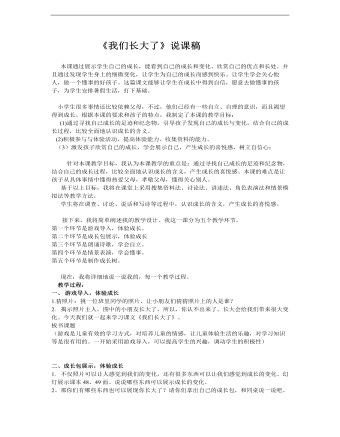
小学科学鄂教版四年级上册《我们长大了》说课稿
小学生很多事情还比较依赖父母,不过,他们已经有一些自立、自理的意识,而且渴望得到成长。根据本课的要求和孩子的特点,我制定了本课的教学目标: (1)通过寻找自己成长的足迹和纪念物,引导孩子发现自己的成长与变化,结合自己的成长过程,比较全面地认识成长的含义。 (2)积极参与与体验活动,提高体验能力、收集资料的能力。 (3)激发孩子欣赏自己的成长,学会展示自己,产生成长的喜悦感,树立自信心; 针对本课教学目标,我认为本课教学的重点是:通过寻找自己成长的足迹和纪念物,结合自己的成长过程,比较全面地认识成长的含义,产生成长的喜悦感。本课的难点是让孩子从具体事情中懂得热爱父母,孝敬父母,懂得关心别人。 基于以上目标,我将在课堂上采用搜集资料法、讨论法、讲述法、角色表演法和情景模拟法等教学方法。
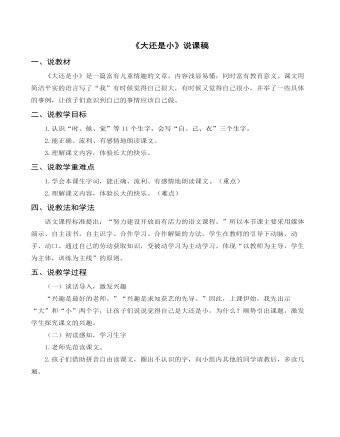
部编人教版一年级上册《大还是小》说课稿
二、说教学目标1.认识“时、候、觉”等11个生字,会写“自、己、衣”三个生字。2.能正确、流利、有感情地朗读课文。3.理解课文内容,体验长大的快乐。三、说教学重难点1.学会本课生字词,能正确、流利、有感情地朗读课文。(重点)?2.理解课文内容,体验长大的快乐。(难点)四、说教法和学法语文课程标准提出:“努力建设开放而有活力的语文课程。”所以本节课主要采用媒体演示、自主读书,自主识字、合作学习、合作解疑的方法。学生在教师的引导下动脑、动手、动口。通过自己的劳动获取知识,变被动学习为主动学习。体现“以教师为主导,学生为主体,训练为主线”的原则。

部编人教版三年级上册《大自然的声音》说课稿
四、说教法学法这篇课文浅显易懂、生动有趣,在教学中应以读为本,应让学生在主动积极的思维和情感活动中,加深理解和体验,有所感悟和思考,受到情感熏陶,获得思想启迪,享受审美乐趣。因此,在教学中,引导学生入境、想象、美读、感悟,引导学生在读中感悟,在读中激情,在读中体验、品味,让学生真正走进大自然,体验大自然,发现大自然,激发学生热爱大自然的感情。 1.创设情境,走进文本:在教学中,要让学生自己阅读、自己学会阅读。教学中我创设了情境,让大自然带领学生聆听了一场特殊的音乐会,缩短了学生与文本的空间距离,让学生置身于自然之中,俨然是大自然中的一员,在情境中感知,体会到大自然声音的美妙,与文本产生了共鸣,激发了学生的学习兴趣,让学生成为学习的主人。 2.美读感悟,放飞想象:在教学中始终以“大自然中这些声音真是太美妙了”贯串始终,重点指导学生美读课文,抓住描写声音的词,边读边思考,大胆的展开想象,有感情地读,配乐读,自由读,分组读,师生合读,全班齐读,在读中生成自己独特的感受、体验和理解,感受风声的美妙,水声的有趣,动物声的快乐,同时培养学生的语感。 3.拓展延伸,提高能力:布置学生课后在大自然找一些新发现,拓展学生的学习空间,扩大视野,增长知识。让学生在课内外的学习中提高语文素养。
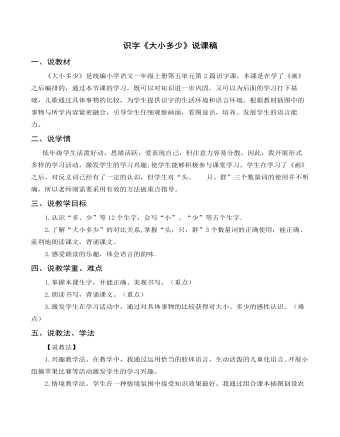
部编人教版一年级上册识字《大小多少》说课稿
五、说教法、学法【说教法】? ???1.兴趣教学法。在教学中,我通过运用恰当的肢体语言、生动活泼的儿童化语言,开展小组摘苹果比赛等活动激发学生的学习兴趣。? ???2.情境教学法。学生在一种情境氛围中接受知识效果最好。我通过组合课本插图创设农家小院情境,通过文本和课件互为直观感知,调动学生的多种感官直接参与学习.? ???3.赏识教学法。低年级的孩子喜欢被表扬。在学生练字,读词、展示学习成果等环节,我灵活运用针对性较强的赏识语言、友善的动作等方式对学生加以赏识。? 【说学法】?1.让学生在合作探究中学。合作探究学习关注的是学生的能力,我通过让学生互相探究记字方法,联系生活自编儿歌,让学生的思维力,想象力,创造力得到充分的展示。???2.让学生在读中学。朗读是学生获得情感体验的重要途径。本课教学以读为本,有目的组织形式多样的读词,读文活动,在反复的诵读中,体会韵文的语言美。???3.让学生在快乐中学。我们常说寓教于乐。本课教学我开展形式多样的教学活动,如开火车游戏,拍手读,小组比赛等,让学生在快乐中积累了语言文字。
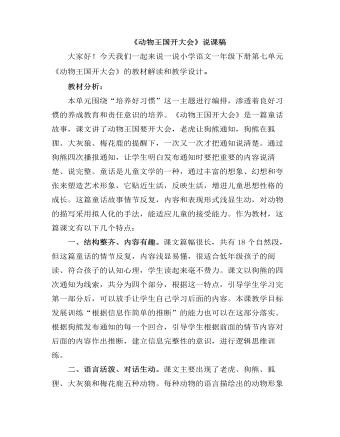
部编人教版一年级下册《动物王国开大会》说课稿
二、语言活泼、对话生动。课文主要出现了老虎、狗熊、狐狸、大灰狼和梅花鹿五种动物。每种动物的语言描绘出的动物形象符合人们心目中动物形象。如“拿着喇叭大声喊……一连喊了十遍”,伸了伸舌头,做了个鬼脸,连忙说:“对,对,对!”“捶捶自己的脑袋”勾画出了一个拿着喇叭大声喊、可爱又憨厚的狗熊。又如老虎的语言中“快去”“再去”等词语体现了老虎是森林大王的威严。文中动物的语言有特点,标点也有特点。如狗熊四次发布通知,都是以感叹号结尾,带有命令、感召的语气,随着内容越来越具体、清楚,语气也越来越强烈,最后一次通知中出现了2个感叹号!祈使句主要集中在狗熊和老虎说的话中。这是狗熊四次发布通知的内容,这四次通知,带有号召、命令的语气,随着发布的内容越来越具体、清楚,语气也越来越强烈!
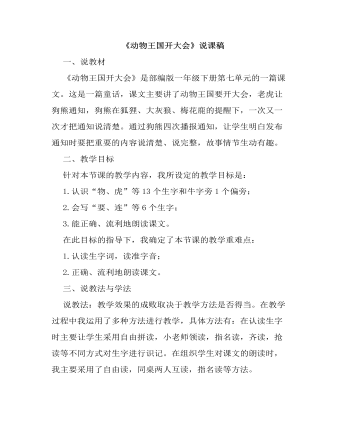
部编人教版一年级下册《动物王国开大会》(说课稿)
三、说教法与学法说教法:教学效果的成败取决于教学方法是否得当。在教学过程中我运用了多种方法进行教学,具体方法有:在认读生字时主要让学生采用自由拼读,小老师领读,指名读,齐读,抢读等不同方式对生字进行识记。在组织学生对课文的朗读时,我主要采用了自由读,同桌两人互读,指名读等方法。说学法:根据一年级学生特点及本节课的目标,本节课主要指导学生采用自主探究、合作交流、成果展示法的学习方法,开展学习活动。四、说教学过程为了更好、更有效地落实教学目标,突出重点,突破难点,我的教学流程有以下四大板块。(一) 情境导入,激发兴趣1.导课环节,首先利用多媒体向学生播放老虎、狗熊、狐狸、梅花鹿等图片,并配以音乐,让学生根据图片说出动物的名字,在轻松、愉悦的氛围中进入新课的学习——《动物王国开大会》。2.在板书课题时,相机教学“动物”的“物”字,在这里要读轻声,认识牛字旁。3.再次齐读课题。
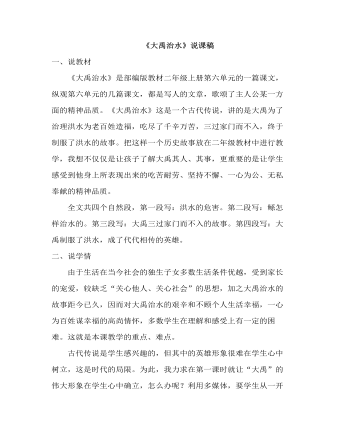
部编人教版二年级上册《大禹治水》说课稿
一、说教材《大禹治水》是部编版教材二年级上册第六单元的一篇课文,纵观第六单元的几篇课文,都是写人的文章,歌颂了主人公某一方面的精神品质。《大禹治水》这是一个古代传说,讲的是大禹为了治理洪水为老百姓造福,吃尽了千辛万苦,三过家门而不入,终于制服了洪水的故事。把这样一个历史故事放在二年级教材中进行教学,我想不仅仅是让孩子了解大禹其人、其事,更重要的是让学生感受到他身上所表现出来的吃苦耐劳、坚持不懈、一心为公、无私奉献的精神品质。全文共四个自然段,第一段写:洪水的危害。第二段写:鲧怎样治水的。第三段写:大禹三过家门而不入的故事。第四段写:大禹制服了洪水,成了代代相传的英雄。

